Understanding Human Activities in Response to Typhoon Hato from Multi-Source Geospatial Big Data: A Case Study in Guangdong, China
Abstract
:1. Introduction
2. Materials
2.1. Study Area and Typhoon Hato
2.2. Data
3. Methods
3.1. Time Series Anomaly Detection
3.2. Human Activity Anomaly Indicators
3.3. Response to Typhoon and Recovery
3.4. Typhoon-Related Microblogs and Topic Analysis
4. Results
4.1. City-Level Human Activities in Response to Hato
4.2. Assessment of Typhoon Process, Cities’ Responses, and Recovery
4.3. Topics of Typhoon-Related Microblogs
4.4. Topic Analysis within Areas with NLR Anomalies
5. Discussion
6. Conclusions
Author Contributions
Funding
Institutional Review Board Statement
Informed Consent Statement
Data Availability Statement
Acknowledgments
Conflicts of Interest
References
- UNDRR (United Nations Office for Disaster Risk Reduction). Economic Losses, Poverty & Disasters: 1998–2017. Available online: https://www.undrr.org/publication/economic-losses-poverty-disasters-1998-2017 (accessed on 12 September 2020).
- Emanuel, K. Increasing destructiveness of tropical cyclones over the past 30 years. Nature 2005, 436, 686–688. [Google Scholar] [CrossRef] [PubMed]
- Webster, P.J.; Holland, G.J.; Curry, J.A.; Chang, H.R. Atmospheric science: Changes in tropical cyclone number, duration, and intensity in a warming environment. Science 2005, 309, 1844–1846. [Google Scholar] [CrossRef] [PubMed] [Green Version]
- Elsner, J.B.; Kossin, J.P.; Jagger, T.H. The increasing intensity of the strongest tropical cyclones. Nature 2008, 455, 92–95. [Google Scholar] [CrossRef]
- Emanuel, K.A. Downscaling CMIP5 climate models shows increased tropical cyclone activity over the 21st century. Proc. Natl. Acad. Sci. USA 2013, 110, 12219–12224. [Google Scholar] [CrossRef] [Green Version]
- Mei, W.; Xie, S.P. Intensification of landfalling typhoons over the northwest Pacific since the late 1970s. Nat. Geosci. 2016, 9, 753–757. [Google Scholar] [CrossRef]
- CNKI (China National Knowledge Infrastructure). Yearbook of Meteorological Disasters in China. Available online: https://data.oversea.cnki.net/chn/yearbook/Single/N2020070612 (accessed on 12 September 2020).
- Voigt, S.; Giulio-Tonolo, F.; Lyons, J.; Kučera, J.; Jones, B.; Schneiderhan, T.; Platzeck, G.; Kaku, K.; Hazarika, M.K.; Czaran, L. Global trends in satellite-based emergency mapping. Science 2016, 353, 247–252. [Google Scholar] [CrossRef] [PubMed]
- Liu, Y.; Liu, X.; Gao, S.; Gong, L.; Kang, C.; Zhi, Y.; Chi, G.; Shi, L. Social Sensing: A New Approach to Understanding Our Socioeconomic Environments. Ann. Assoc. Am. Geogr. 2015, 105, 512–530. [Google Scholar] [CrossRef]
- Imran, M.; Elbassuoni, S.; Castillo, C.; Diaz, F.; Meier, P. Extracting information nuggets from disaster- Related messages in social media. In Proceedings of the ISCRAM 2013 Conference Proceedings—10th International Conference on Information Systems for Crisis Response and Management, Baden-Baden, Germany, 12–15 May 2013; pp. 791–801. [Google Scholar]
- Zhao, Q.; Chen, Z.; Liu, C.; Luo, N. Extracting and classifying typhoon disaster information based on volunteered geographic information from Chinese Sina microblog. Concurr. Comput. Pract. Exp. 2019, 31, e4910. [Google Scholar] [CrossRef]
- Yu, J.; Zhao, Q.; Chin, C.S. Extracting typhoon disaster information from VGI based on machine learning. J. Mar. Sci. Eng. 2019, 7, 318. [Google Scholar] [CrossRef] [Green Version]
- Fan, C.; Wu, F.; Mostafavi, A. A Hybrid Machine Learning Pipeline for Automated Mapping of Events and Locations from Social Media in Disasters. IEEE Access 2020, 8, 10478–10490. [Google Scholar] [CrossRef]
- Bagrow, J.P.; Wang, D.; Barabasi, A.L. Collective Response of Human Populations to Large-Scale Emergencies. PLoS ONE 2011, 6, e17680. [Google Scholar] [CrossRef] [PubMed] [Green Version]
- D’Agostino, G.; Tofani, A. Obserbot: A Totally Automated Watcher to Monitor Essential Services. In Proceedings of the International Conference on Advanced Information Networking and Applications, Toronto, ON, Canada, 12–14 May 2021; Springer: Berlin/Heidelberg, Germany, 2021; pp. 149–158. [Google Scholar]
- Vieweg, S.; Hughes, A.L.; Starbird, K.; Palen, L. Microblogging during two natural hazards events: What twitter may contribute to situational awareness. Conf. Hum. Factors Comput. Syst.-Proc. 2010, 2, 1079–1088. [Google Scholar] [CrossRef]
- Huang, Q.; Xiao, Y. Geographic situational awareness: Mining tweets for disaster preparedness, emergency response, impact, and recovery. ISPRS Int. J. Geo-Inf. 2015, 4, 1549–1568. [Google Scholar] [CrossRef] [Green Version]
- Yu, M.; Huang, Q.; Qin, H.; Scheele, C.; Yang, C. Deep learning for real-time social media text classification for situation awareness–using Hurricanes Sandy, Harvey, and Irma as case studies. Int. J. Digit. Earth 2019, 12, 1230–1247. [Google Scholar] [CrossRef]
- Fan, C.; Jiang, Y.; Mostafavi, A. Social Sensing in Disaster City Digital Twin: Integrated Textual–Visual–Geo Framework for Situational Awareness during Built Environment Disruptions. J. Manag. Eng. 2020, 36, 04020002. [Google Scholar] [CrossRef]
- Wang, Z.; Ye, X. Space, time, and situational awareness in natural hazards: A case study of Hurricane Sandy with social media data Hurricane Sandy with social media data. Cartogr. Geogr. Inf. Sci. 2019, 46, 334–346. [Google Scholar] [CrossRef]
- Wang, Q.; Taylor, J.E. Quantifying human mobility perturbation and resilience in hurricane sandy. PLoS ONE 2014, 9, e112608. [Google Scholar] [CrossRef]
- Zou, L.; Lam, N.S.N.; Cai, H.; Qiang, Y. Mining Twitter Data for Improved Understanding of Disaster Resilience. Ann. Am. Assoc. Geogr. 2018, 108, 1422–1441. [Google Scholar] [CrossRef]
- Wang, Y. Tracking Disaster Dynamics for Urban Resilience: Human-Mobility and Semantic Perspectives. Ph.D. Thesis, Virginia Tech, Blacksburg, VA, USA, 12 April 2018. [Google Scholar]
- Yabe, T.; Tsubouchi, K.; Fujiwara, N.; Sekimoto, Y.; Ukkusuri, S.V. Understanding post-disaster population recovery patterns. J. R. Soc. Interface 2020, 17, 20190532. [Google Scholar] [CrossRef] [Green Version]
- Eyre, R.; De Luca, F.; Simini, F. Social media usage reveals recovery of small businesses after natural hazard events. Nat. Commun. 2020, 11, 1629. [Google Scholar] [CrossRef]
- Wang, K.; Lam, N.S.N.; Zou, L.; Mihunov, V. Twitter use in hurricane isaac and its implications for disaster resilience. ISPRS Int. J. Geo-Inf. 2021, 10, 116. [Google Scholar] [CrossRef]
- Kryvasheyeu, Y.; Chen, H.; Obradovich, N.; Moro, E.; Van Hentenryck, P.; Fowler, J.; Cebrian, M. Rapid assessment of disaster damage using social media activity. Sci. Adv. 2016, 2, e1500779. [Google Scholar] [CrossRef] [PubMed] [Green Version]
- Nguyen, D.T.; Ofli, F.; Imran, M.; Mitra, P. Damage assessment from social media imagery data during disasters. In Proceedings of the 2017 IEEE/ACM International Conference on Advances in Social Networks Analysis and Mining ASONAM 2017, Sydney, Australia, 31 July–3 August 2017; pp. 569–576. [Google Scholar] [CrossRef]
- Cervone, G.; Schnebele, E.; Waters, N.; Moccaldi, M.; Sicignano, R. Using Social Media and Satellite Data for Damage Assessment in Urban Areas during Emergencies BT—Seeing Cities through Big Data: Research, Methods and Applications in Urban Informatics. In Seeing Cities through Big Data; Thakuriah, P., Tilahun, N., Zellner, M., Eds.; Springer International Publishing: Cham, Switzerland, 2017; pp. 443–457. [Google Scholar] [CrossRef]
- Resch, B.; Usländer, F.; Havas, C. Combining machine-learning topic models and spatiotemporal analysis of social media data for disaster footprint and damage assessment. Cartogr. Geogr. Inf. Sci. 2018, 45, 362–376. [Google Scholar] [CrossRef] [Green Version]
- Yuan, F.; Liu, R. Integration of social media and unmanned aerial vehicles (UAVs) for rapid damage assessment in hurricane matthew. In Proceedings of the Construction Research Congress 2018, New Orleans, LA, USA, 2–4 April 2018; pp. 513–523. [Google Scholar] [CrossRef]
- Li, X.; Caragea, D.; Zhang, H.; Imran, M. Localizing and quantifying damage in social media images. In Proceedings of the 2018 IEEE/ACM International Conference on Advances in Social Networks Analysis and Mining (ASONAM), Barcelona, Spain, 28–31 August 2018; pp. 194–201. [Google Scholar] [CrossRef] [Green Version]
- Hong, B.; Bonczak, B.J.; Gupta, A.; Kontokosta, C.E. Measuring inequality in community resilience to natural disasters using large-scale mobility data. Nat. Commun. 2021, 12, 1870. [Google Scholar] [CrossRef] [PubMed]
- Ahmad, K.; Pogorelov, K.; Riegler, M.; Conci, N.; Halvorsen, P. Social media and satellites: Disaster event detection, linking and summarization. Multimed. Tools Appl. 2019, 78, 2837–2875. [Google Scholar] [CrossRef]
- Qi, L.; Li, J.; Wang, Y.; Gao, X. Urban Observation: Integration of Remote Sensing and Social Media Data. IEEE J. Sel. Top. Appl. Earth Obs. Remote Sens. 2019, 12, 4252–4264. [Google Scholar] [CrossRef]
- Wang, Z.; Ye, X. Social media analytics for natural disaster management. Int. J. Geogr. Inf. Sci. 2018, 32, 49–72. [Google Scholar] [CrossRef]
- Said, N.; Ahmad, K.; Riegler, M.; Pogorelov, K.; Hassan, L.; Ahmad, N.; Conci, N. Natural disasters detection in social media and satellite imagery: A survey. Multimed. Tools Appl. 2019, 78, 31267–64615. [Google Scholar] [CrossRef] [Green Version]
- Ma, T. Multi-level relationships between satellite-derived nighttime lighting signals and social media-derived human population dynamics. Remote Sens. 2018, 10, 1128. [Google Scholar] [CrossRef] [Green Version]
- Ma, T.; Pei, T.; Song, C.; Liu, Y.; Du, Y.; Liao, X. Understanding geographical patterns of a city’s diurnal rhythm from aggregate data of location-aware services. Trans. GIS 2019, 23, 104–117. [Google Scholar] [CrossRef]
- Ma, T. An estimate of the pixel-level connection between visible infrared imaging radiometer suite day/night band (VIIRS DNB) nighttime lights and land features across China. Remote Sens. 2018, 10, 723. [Google Scholar] [CrossRef] [Green Version]
- Liu, Z.; Du, Y.; Yi, J.; Liang, F.; Ma, T.; Pei, T. Quantitative association between nighttime lights and geo-tagged human activity dynamics during Typhoon Mangkhut. Remote Sens. 2019, 11, 2091. [Google Scholar] [CrossRef] [Green Version]
- Liu, Z.; Du, Y.; Yi, J.; Liang, F.; Ma, T.; Pei, T. Quantitative estimates of collective geo-tagged human activities in response to typhoon Hato using location-aware big data. Int. J. Digit. Earth 2020, 13, 1072–1092. [Google Scholar] [CrossRef]
- Yang, J.; Li, L.; Zhao, K.; Wang, P.; Wang, D.; Sou, I.M.; Yang, Z.; Hu, J.; Tang, X.; Mok, K.M. A comparative study of Typhoon Hato (2017) and Typhoon Mangkhut (2018)—Their impacts on coastal inundation in Macau. J. Geophys. Res. Oceans 2019, 124, 9590–9619. [Google Scholar] [CrossRef]
- Sui, G.; Tang, D.; Chen, H. Economic Influence of Typhoon Catastrophe and the Construction of Recovery System. Int. Econ. Trade Res. 2010, 2, 32–36. [Google Scholar] [CrossRef]
- China Weather Website. Available online: http://typhoon.weather.com.cn/ (accessed on 31 August 2017).
- Tencent’s Location Big Data Portal. Available online: http://heat.qq.com (accessed on 31 August 2017).
- Ma, T.; Lu, R.; Zhao, N.; Shaw, S.-L. An estimate of rural exodus in China using location-aware data. PLoS ONE 2018, 13, e0201458. [Google Scholar] [CrossRef]
- Yi, J.; Du, Y.; Liang, F.; Tu, W.; Qi, W.; Ge, Y. Mapping human’s digital footprints on the Tibetan Plateau from multi-source geospatial big data. Sci. Total Environ. 2020, 711, 134540. [Google Scholar] [CrossRef]
- Cheng, Z.; Wang, J.; Ge, Y. Mapping monthly population distribution and variation at 1-km resolution across China. Int. J. Geogr. Inf. Sci. 2020, 1–19. [Google Scholar] [CrossRef]
- Sina Weibo Platform. Available online: https://weibo.com/ (accessed on 31 August 2017).
- China Meteorological Data Service Centre. Available online: http://data.cma.cn/ (accessed on 7 September 2017).
- Hochenbaum, J.; Vallis, O.S.; Kejariwal, A. Automatic Anomaly Detection in the Cloud Via Statistical Learning. arXiv 2017, arXiv:1704.07706. [Google Scholar]
- Cheng, X.; Yan, X.; Lan, Y.; Guo, J. BTM: Topic modeling over short texts. IEEE Trans. Knowl. Data Eng. 2014, 26, 2928–2941. [Google Scholar] [CrossRef]
- Rus, K.; Kilar, V.; Koren, D. Resilience assessment of complex urban systems to natural disasters: A new literature review. Int. J. Disaster Risk Reduct. 2018, 31, 311–330. [Google Scholar] [CrossRef]
- Kontokosta, C.E.; Malik, A. The Resilience to Emergencies and Disasters Index: Applying big data to benchmark and validate neighborhood resilience capacity. Sustain. Cities Soc. 2018, 36, 272–285. [Google Scholar] [CrossRef]
- Ligutom, C.; Orio, J.V.; Ramacho, D.A.M.; Montenegro, C.; Roxas, R.E.; Oco, N. Using Topic Modelling to make sense of typhoon-related tweets. In Proceedings of the 2016 International Conference on Asian Language Processing (IALP), Tainan, Taiwan, 21–23 November 2016; pp. 362–365. [Google Scholar] [CrossRef]
- Gorro, K.; Ancheta, J.R.; Capao, K.; Oco, N.; Roxas, R.E.; Sabellano, M.J.; Nonnecke, B.; Mohanty, S.; Crittenden, C.; Goldberg, K. Qualitative data analysis of disaster risk reduction suggestions assisted by topic modeling and word2vec. In Proceedings of the 2017 International Conference on Asian Language Processing (IALP), Singapore, 5–7 December 2017; pp. 293–297. [Google Scholar] [CrossRef]
- Rudra, K.; Goyal, P.; Ganguly, N.; Mitra, P.; Imran, M. Identifying sub-events and summarizing disaster-related information from microblogs. In Proceedings of the 41st International ACM SIGIR Conference on Research & Development in Information Retrievalc (SIGIR’18), Ann Arbor, MI, USA, 8–12 July 2018; pp. 265–274. [Google Scholar] [CrossRef]
- Zhang, T.; Shen, S.; Cheng, C.; Su, K.; Zhang, X. A topic model based framework for identifying the distribution of demand for relief supplies using social media data. Int. J. Geogr. Inf. Sci. 2021, 35, 2216–2237. [Google Scholar] [CrossRef]
- Blei, D.M.; Ng, A.Y.; Jordan, M.T. Latent dirichlet allocation. Adv. Neural Inf. Process. Syst. 2002, 3, 993–1022. [Google Scholar]
- Vongkusolkit, J.; Huang, Q. Situational awareness extraction: A comprehensive review of social media data classification during natural hazards. Ann. GIS 2021, 27, 5–28. [Google Scholar] [CrossRef]
- Yi, J.; Du, Y.; Liang, F.; Pei, T.; Ma, T.; Zhou, C. Anomalies of dwellers’ collective geotagged behaviors in response to rainstorms: A case study of eight cities in China using smartphone location data. Nat. Hazards Earth Syst. Sci. 2019, 19, 2169–2182. [Google Scholar] [CrossRef] [Green Version]
- Getis, A.; Ord, J.K. The Analysis of Spatial Association by Use of Distance Statistics. In Perspectives on Spatial Data Analysis. Advances in Spatial Science; The Regional Science Series; Anselin, L., Rey, S., Eds.; Springer: Berlin/Heidelberg, Germany, 2010; pp. 127–145. [Google Scholar] [CrossRef]
- Wu, D.; Cui, Y. Disaster early warning and damage assessment analysis using social media data and geo-location information. Decis. Support Syst. 2018, 111, 48–59. [Google Scholar] [CrossRef]
- Shan, S.; Zhao, F.; Wei, Y.; Liu, M. Disaster management 2.0: A real-time disaster damage assessment model based on mobile social media data—A case study of Weibo (Chinese Twitter). Saf. Sci. 2019, 115, 393–413. [Google Scholar] [CrossRef]
- Yuan, F.; Liu, R. Mining social media data for rapid damage assessment during Hurricane Matthew: Feasibility study. J. Comput. Civ. Eng. 2020, 34, 5020001. [Google Scholar] [CrossRef]
- Palen, L.; Anderson, K.M. Crisis informatics—New data for extraordinary times. Science 2016, 353, 224–225. [Google Scholar] [CrossRef] [Green Version]
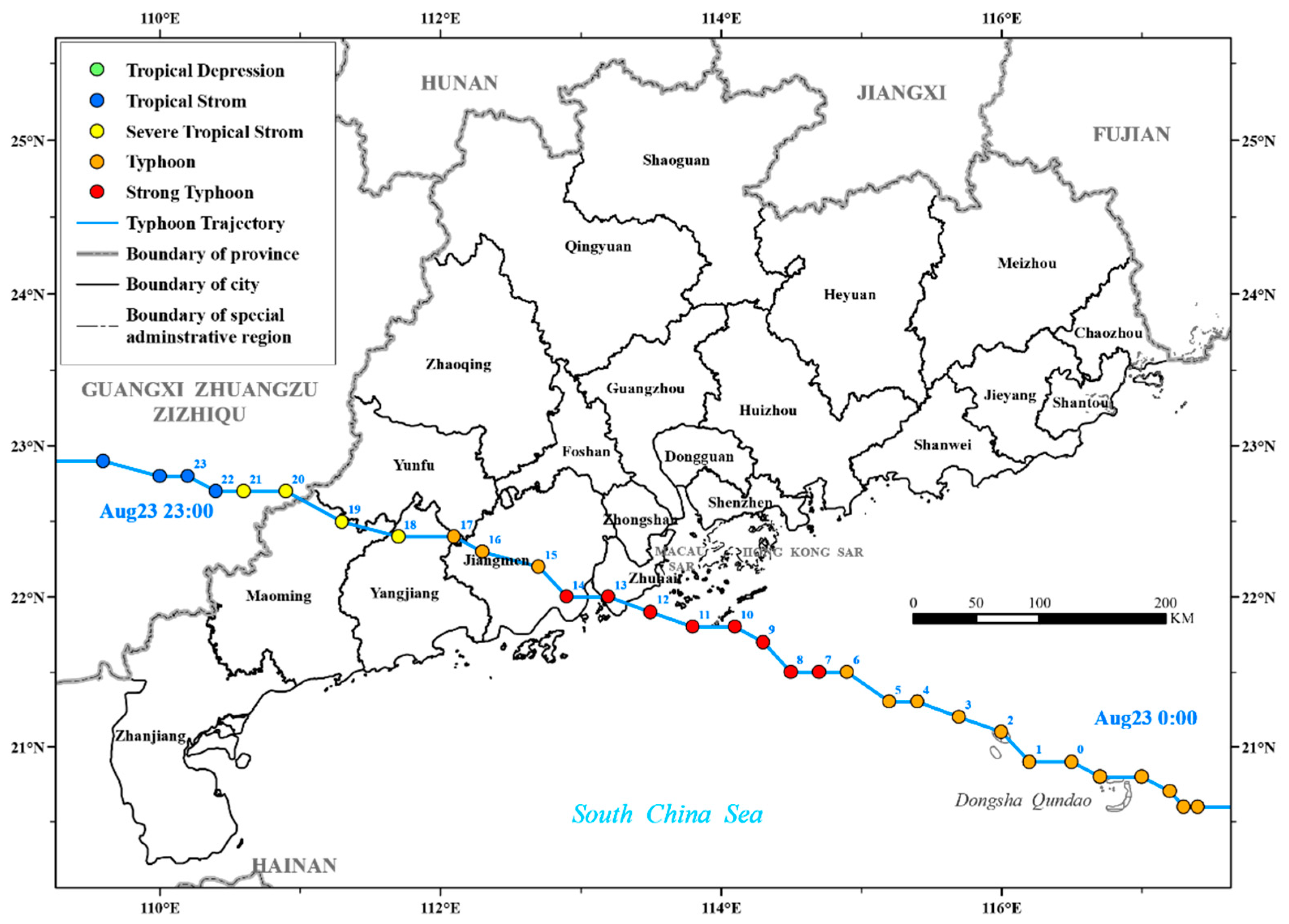
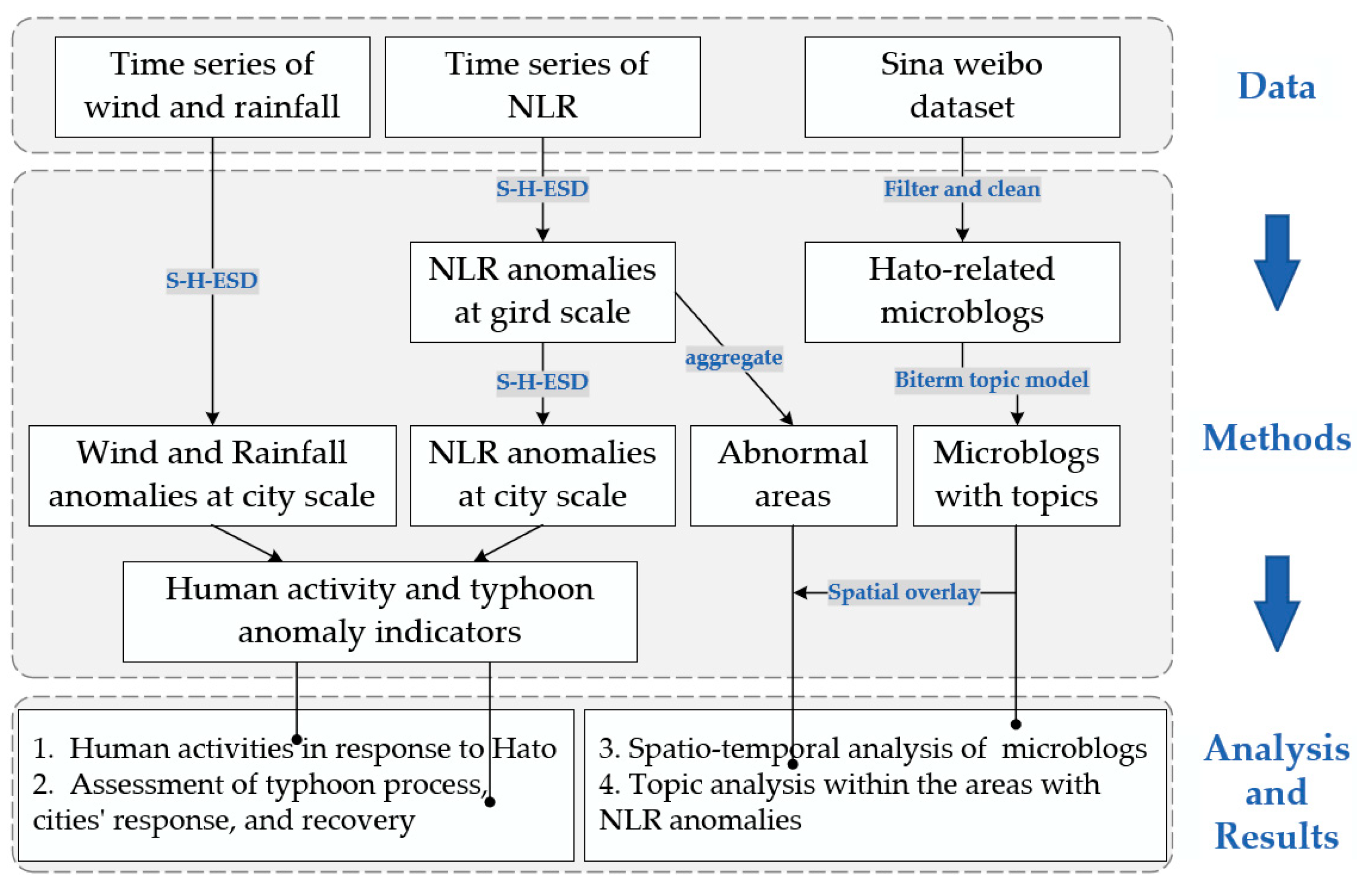
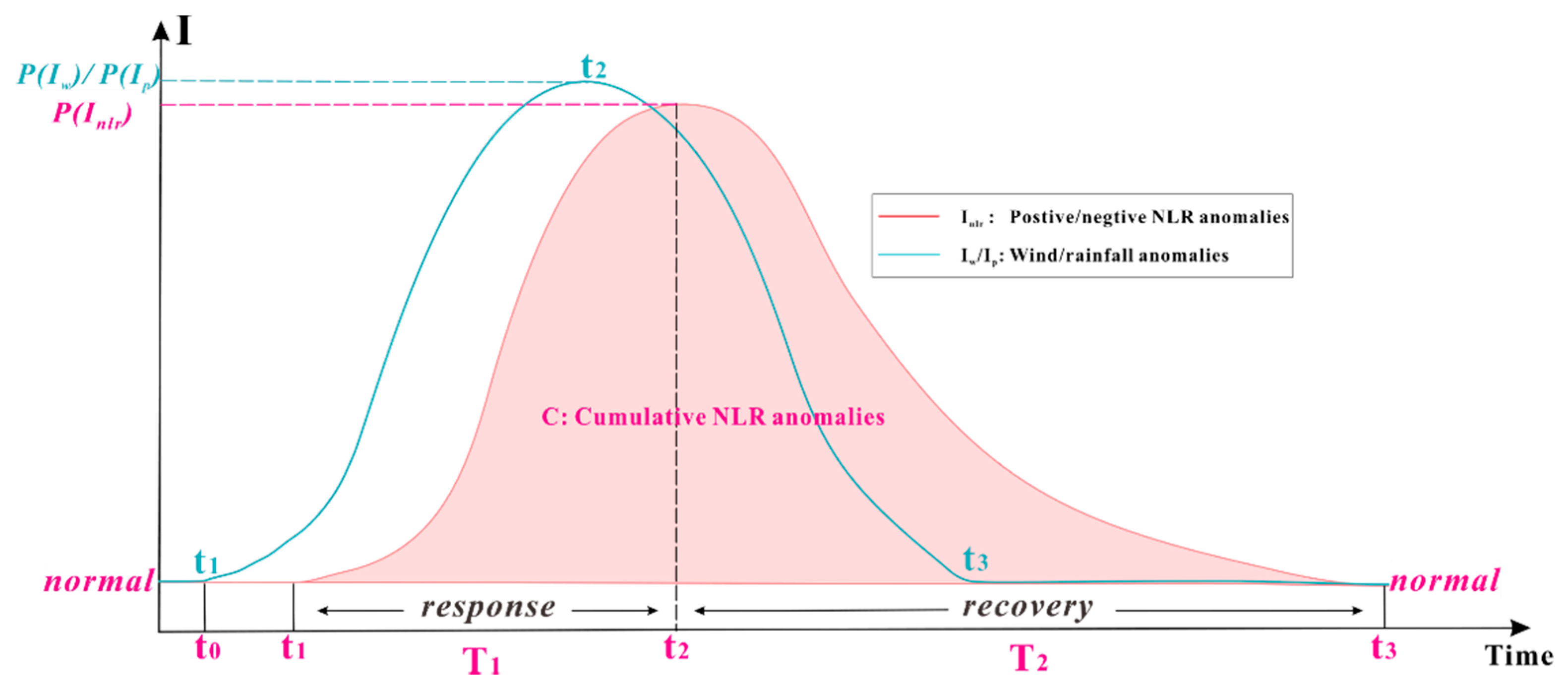
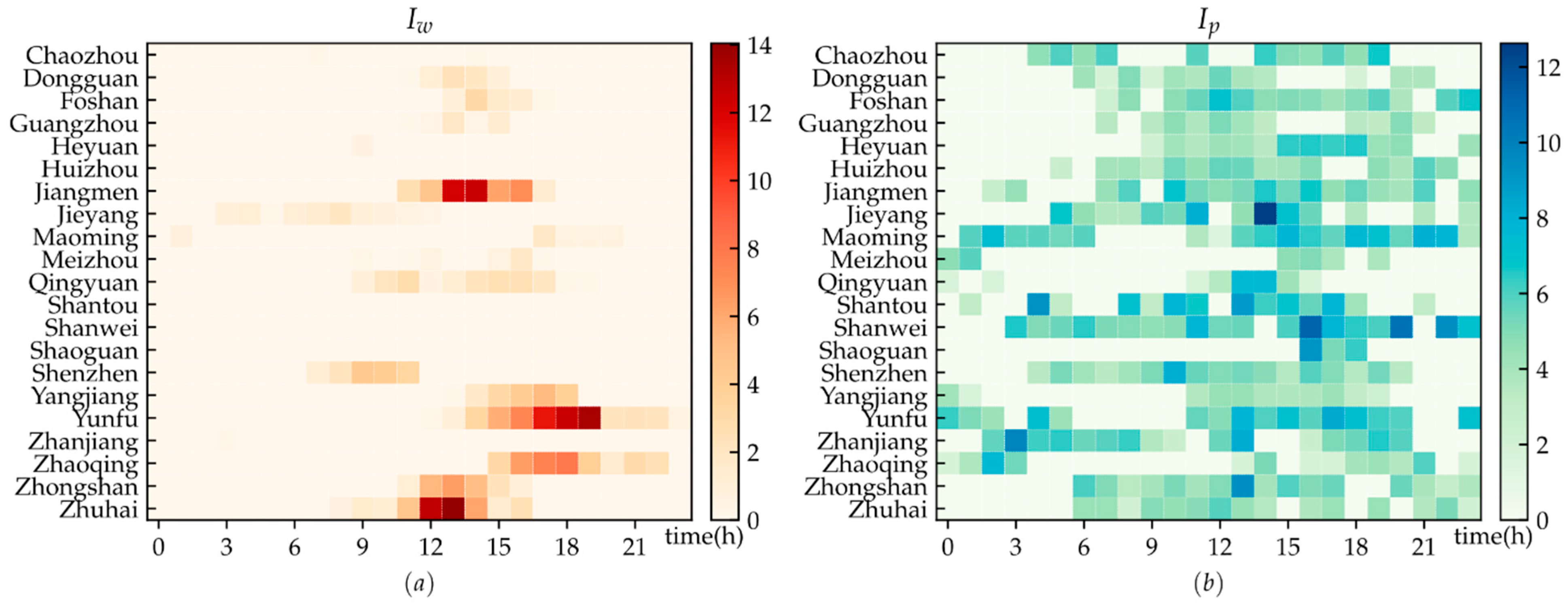
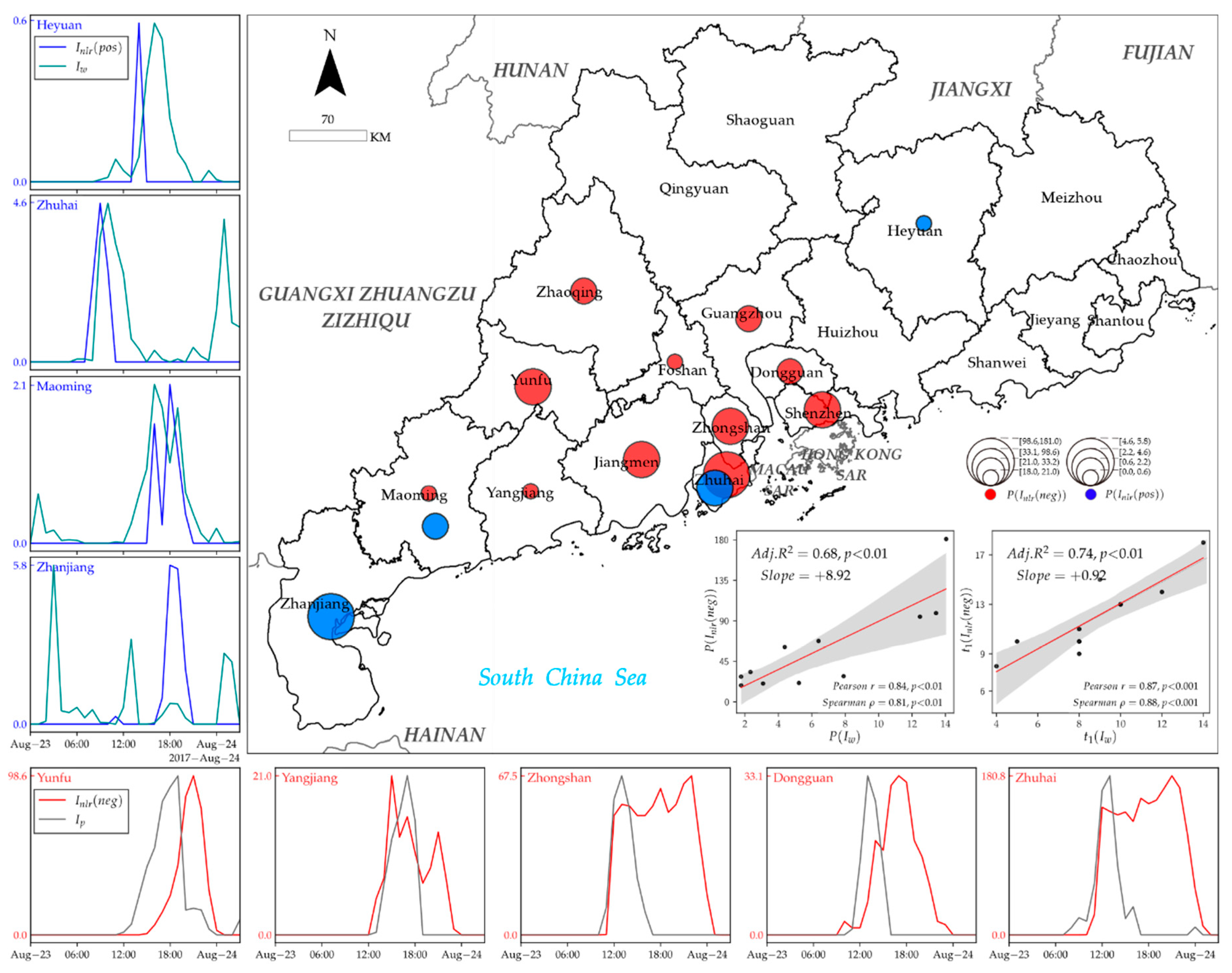
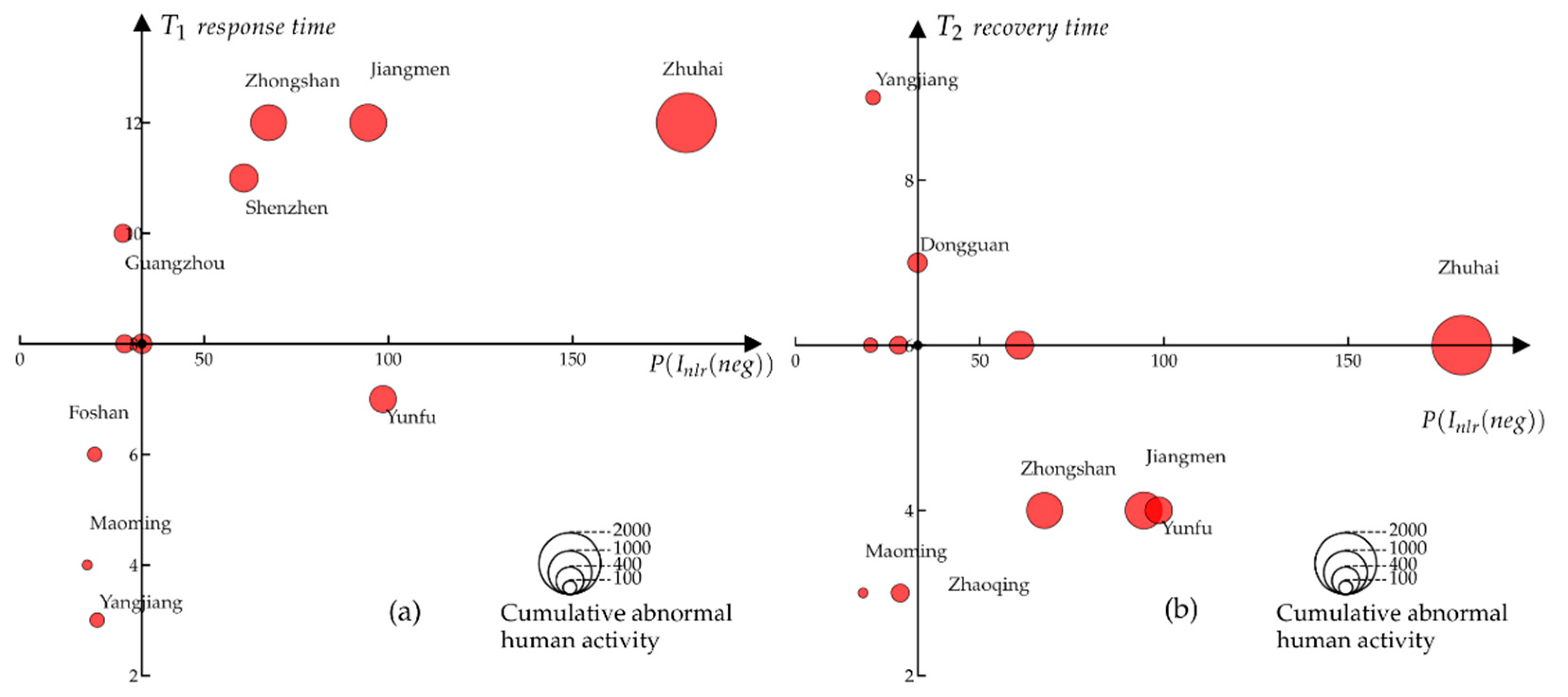
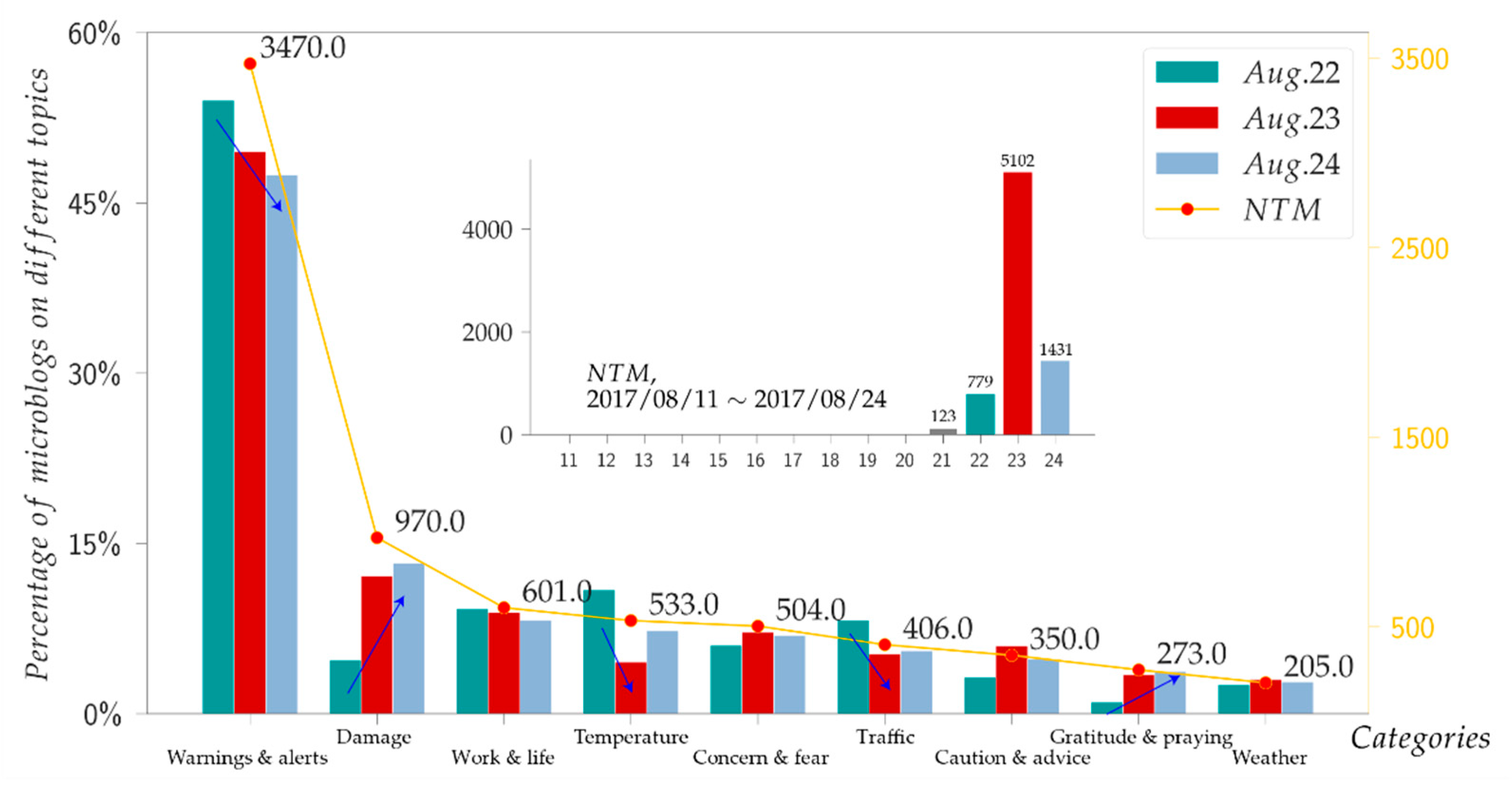
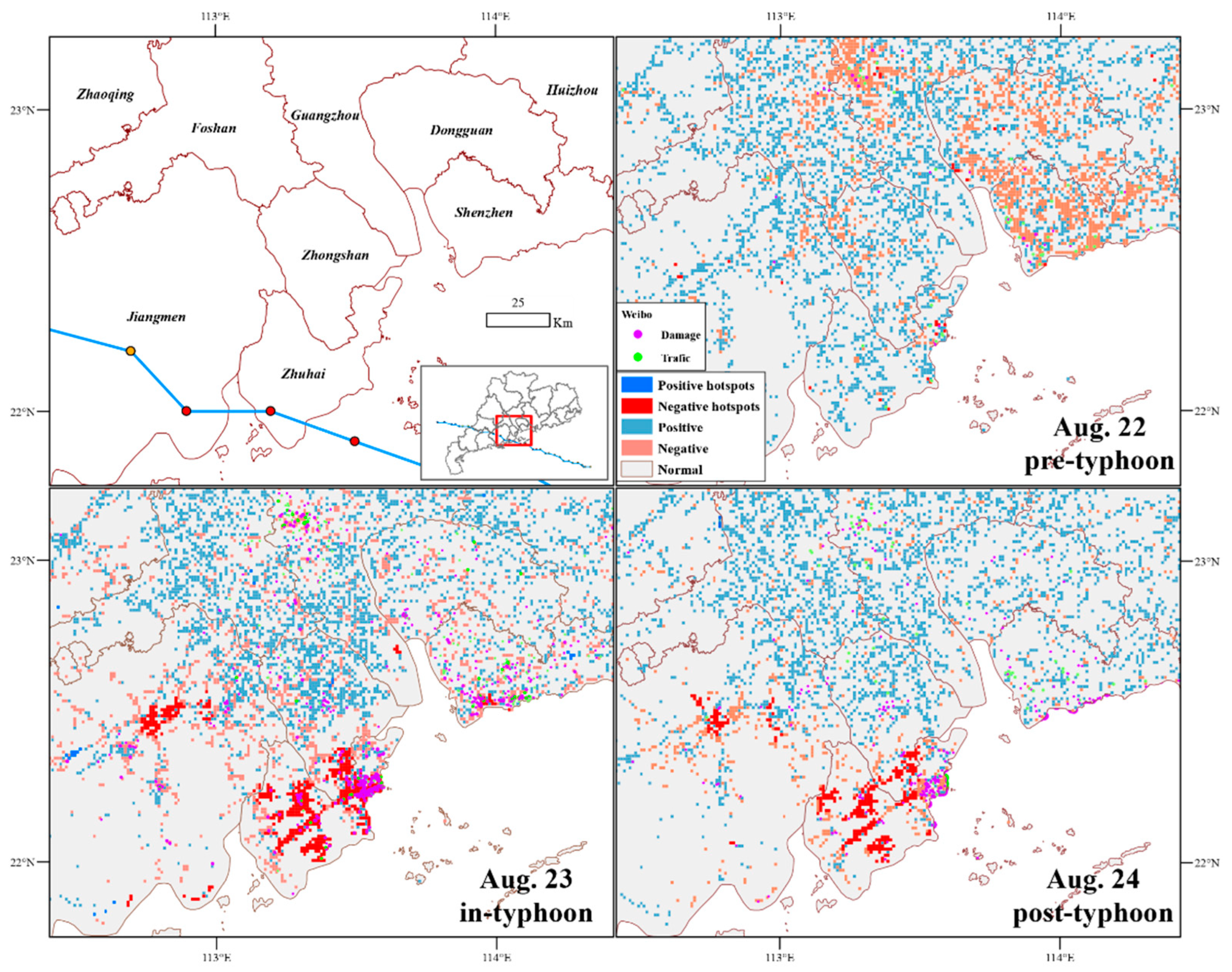
| Objects | Indicators | Scale |
|---|---|---|
| Typhoon | : The intensity of rainfall anomalies | City; hourly |
| : The intensity of wind speed anomalies | City; hourly | |
| Human activity | : The intensity of positive and negative NLR anomalies at gird scale | Grid; hourly |
| : The intensity of positive and negative NLR anomalies at city scale | City; hourly |
| Targets | Indicators | Values |
|---|---|---|
| Typhoon characteristics | ||
| Human activity anomalies | ||
| Cumulative NLR anomalies | ||
| Duration of response | ||
| Duration of recovery |
| Indicator | A | B | C | D | E | F | G | H | I |
|---|---|---|---|---|---|---|---|---|---|
| Precision | 0.74 | 0.71 | 0.73 | 0.60 | 0.63 | 0.60 | 0.91 | 0.55 | 0.71 |
| Recall | 0.92 | 0.65 | 0.43 | 0.76 | 0.52 | 0.65 | 0.75 | 0.43 | 0.5 |
| Overall accuracy = 70.3% | |||||||||
| Y (log Scale) | X (log Scale) | Slope | RSE | |
|---|---|---|---|---|
| Economic loss | 3.581 | 0.62 * | 1.823 | |
| 3.1556 | 0.80 ** | 1.341 | ||
| 2.1459 | 0.72 ** | 1.584 | ||
| Affected population | 2.596 | 0.57 | 1.366 | |
| 2.1458 | 0.71 * | 1.134 | ||
| 1.7832 | 0.84 * | 0.8485 |
| Topic Codes | Meaningful High-Frequency Words | Categories | Description | Percentage |
|---|---|---|---|---|
| A | Shenzhen, Zhuhai, landing, early warning, Guangdong, holiday. Guangzhou, heavy rain, red, powerful typhoon, Zhongshan, safety, closed, shutdown, suspend classes | Warnings and alerts | Disaster warning and notification | 47.46% |
| B | Zhuhai, after, power failure, water supply, recovery, serious, the sea, community, Shenzhen, trees, scared | Damage | Damage related | 13.27% |
| C | Go to work, the company, go out, work, holiday, weather, at home, customers, outside, heavy rain, study | Work and life | Daily life | 8.22% |
| D | After, weather, Shenzhen, sky, stopping the heat, cool, comfortable, heavy rain, cool, calm, feeling, sultry, hot | Temperature | Cool; positive emotion | 7.29% |
| E | Experience, terrible, power, terror, go out, badly, feeling, Guangdong, Zhuhai, life, hope, Shenzhen, blow away, Guangzhou, home, Dongguan | Concern and fear | Negative emotion | 6.89% |
| F | Guangzhou, Shenzhen, shut down, hours, flight, now, go home, plane, influence, late, high-speed rail, delay, cancel, subway, trapped, Zhuhai | Traffic | Affected traffic | 5.55% |
| G | Go out, CAUTION, remember, incoming, Shenzhen, don’t, tip, danger, wind, rain gear, rain, indoor, stay away from, sea, be careful, river | Caution and advice | Tips on dangerous places and safety measures | 4.79% |
| H | Nature, Zhuhai, after, city, peace, cherish, small, side, hard work, thank you, humans, personnel, devastated, hope, life, work, salute | Gratitude and praying | Gratitude to the staff and prayer to the city | 3.73% |
| I | The heavy rain, the storm, the wind, terrible, quiet, fierce, balcony, wind blows, go home, the office, wind | Weather | The weather conditions | 2.80% |
| Area_1 | Area_2 | A | B | C | D | E | F | G | H | I |
|---|---|---|---|---|---|---|---|---|---|---|
| Positive | Normal | 0.44 -- | 0.16 +++ | 0.08 | 0.07 -- | 0.08 | 0.08 ++ | 0.04 -- | 0.03 | 0.04 |
| Negative | Normal | 0.48 | 0.17 +++ | 0.08 | 0.05 --- | 0.08 + | 0.04 -- | 0.04 -- | 0.04 | 0.02 |
| Negative | Positive | 0.48 ++ | 0.17 | 0.08 | 0.05 -- | 0.08 | 0.04 --- | 0.04 | 0.04 | 0.02 |
| Positive hotspots | × | × | × | × | × | × | × | × | × | × |
| Negative hotspots | Negative | 0.41 --- | 0.28 +++ | 0.05 -- | 0.02 -- | 0.11 ++ | 0.02 -- | 0.02 -- | 0.06 ++ | 0.02 |
| Normal | 0.41 --- | 0.28 +++ | 0.05 --- | 0.02 --- | 0.11 +++ | 0.02 --- | 0.02 --- | 0.06 | 0.02 | |
| Positive | 0.41 | 0.28 +++ | 0.05 | 0.02 --- | 0.11 +++ | 0.02 --- | 0.02 - | 0.06 ++ | 0.02 |
Publisher’s Note: MDPI stays neutral with regard to jurisdictional claims in published maps and institutional affiliations. |
© 2022 by the authors. Licensee MDPI, Basel, Switzerland. This article is an open access article distributed under the terms and conditions of the Creative Commons Attribution (CC BY) license (https://creativecommons.org/licenses/by/4.0/).
Share and Cite
Huang, S.; Du, Y.; Yi, J.; Liang, F.; Qian, J.; Wang, N.; Tu, W. Understanding Human Activities in Response to Typhoon Hato from Multi-Source Geospatial Big Data: A Case Study in Guangdong, China. Remote Sens. 2022, 14, 1269. https://doi.org/10.3390/rs14051269
Huang S, Du Y, Yi J, Liang F, Qian J, Wang N, Tu W. Understanding Human Activities in Response to Typhoon Hato from Multi-Source Geospatial Big Data: A Case Study in Guangdong, China. Remote Sensing. 2022; 14(5):1269. https://doi.org/10.3390/rs14051269
Chicago/Turabian StyleHuang, Sheng, Yunyan Du, Jiawei Yi, Fuyuan Liang, Jiale Qian, Nan Wang, and Wenna Tu. 2022. "Understanding Human Activities in Response to Typhoon Hato from Multi-Source Geospatial Big Data: A Case Study in Guangdong, China" Remote Sensing 14, no. 5: 1269. https://doi.org/10.3390/rs14051269
APA StyleHuang, S., Du, Y., Yi, J., Liang, F., Qian, J., Wang, N., & Tu, W. (2022). Understanding Human Activities in Response to Typhoon Hato from Multi-Source Geospatial Big Data: A Case Study in Guangdong, China. Remote Sensing, 14(5), 1269. https://doi.org/10.3390/rs14051269







